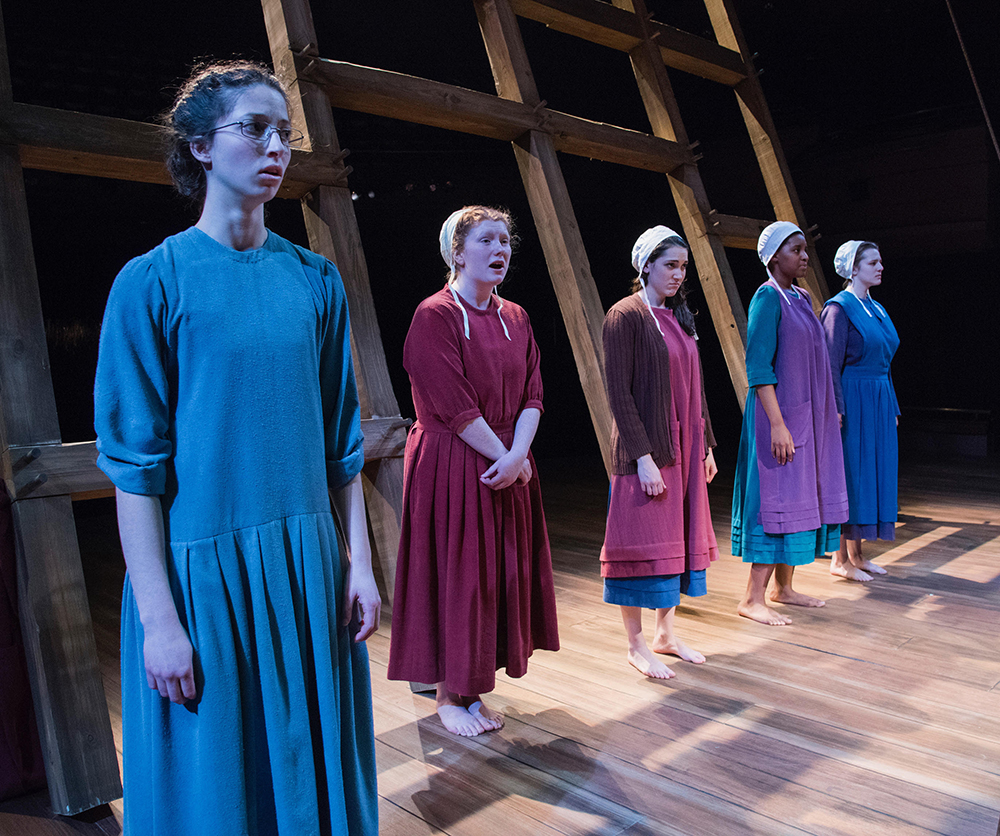When tragedy occurs, humans are often confronted with the difficult choice to forgive and overcome any self-inflicted pain or hold onto anger and prolong suffering. Jessica Dickey’s The Amish Project, presented by the School of Theatre, Dance and Performance Studies, demonstrates the complex power dynamic at play when overcoming personal offenses.
As five young women enter the dimly lit stage, we hear cascading voices say four powerful words that could have defined a small Amish community nearly 10 years ago: “man enters Amish schoolhouse.”
But the play is about so much more than that.
“[The Amish] understand the corrosive and dangerous side effects of anger,” director Mitch Hébert said. “If they hold onto the rage and anger, it could destroy their community. They forgive because it’s a survival mechanism for them.”
As the play depicts the fictionalized aftermath of the real-life West Nickel Mines Amish School shooting from 2006, The Amish Project displays how forgiveness is a necessary process, one often forgotten in our culture of retribution and justice. Originally written as a one-woman show, each cast member takes on two roles, one of an Amish schoolgirl and one of a non-Amish person, to capture the visceral aspects of the plot.
The perpetrator of the shooting is a character named Eddie, based on the real life Charles Carl Roberts IV, and is played by senior theatre major Tamar Gasko.
“In some way, when something intense happens to an English [non-Amish] character, that intensity is happening to the Amish girl inside,” she said. “The Amish girl is feeling that and also responding. That’s a way we bring all our characters together.”
The cast’s research into Amish culture shines through. Cast members watched several YouTube videos on Rumspringa — or “running around,” the period between childhood and baptism when Amish youth receive increased freedom from their families — and took careful notes on how their characters would respond to several situations. Some roles are inquisitive, while others are stoic or confused, and watching such a young cast effortlessly transform from innocent, playful children to mature characters of varying personalities was truly impressive.
“I’ve directed lots of people. I have not directed anybody like these five women,” Hébert said.
As you watch the show, you can see how delicately the production was crafted for the school, especially because it is complemented with such an interesting set, designed by Matthew Buttrey, a scenic design graduate student. Unlike most productions, the audience is on stage looking out to the traditional seats.
The idea to put the audience on stage came as Hébert and Buttrey discussed the themes they wanted to emulate — themes of community, forgiveness and inclusivity. When designing, Buttrey noticed how the play’s nature defied the lavish trend set designers often gravitate to.
“This show is so simple and I think it would do it injustice to complicate it with a barrage of images and symbolism,” Buttrey said.
Indeed, the set is simple, yet incredibly powerful as the characters occupy every space while they display their emotions. Every chair each audience member sits on is unique, bounded together only by color and size and truly complements the versatility of the characters.
The show somehow finds a balance between counseling its audience and allowing them to retain the freedom to choose their philosophies. We have a tendency to see our peers as all bad or all good — a psychological process called splitting– yet the story carefully demonstrates why overcoming this is essential to not only reaching emotional maturity, but sustaining it and living fulfilling lives, even when faced with hardships.
“It’s like a light being put out, as opposed to a physical, violent act. Somehow the girls transcend that,” Hébert said. “Their bodies were taken from them, but their spirit is so powerful that it continues to live on.”



